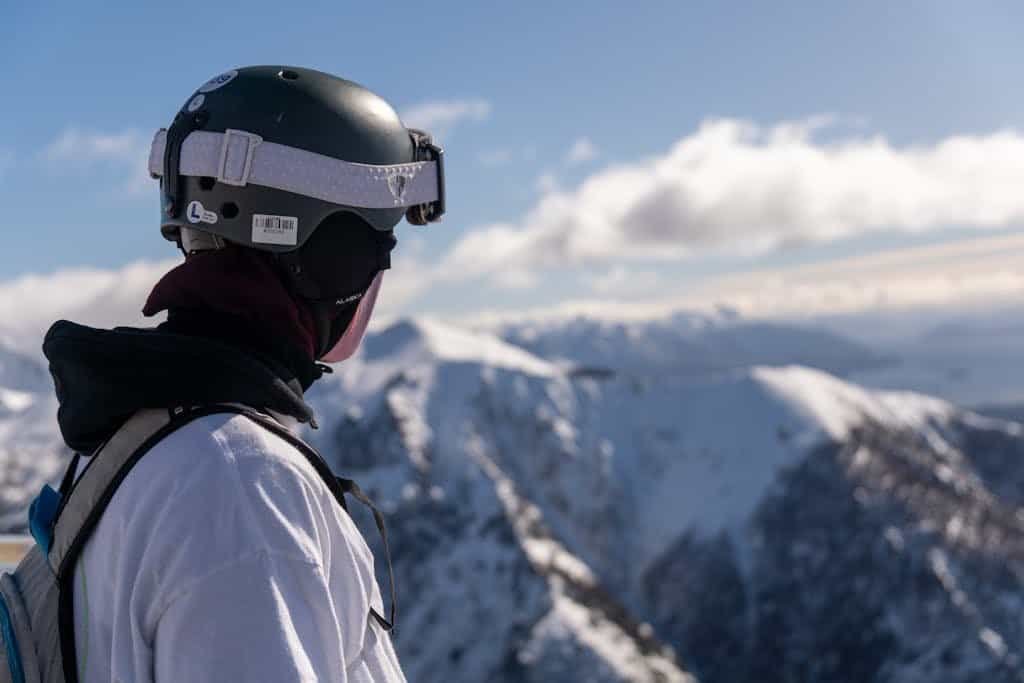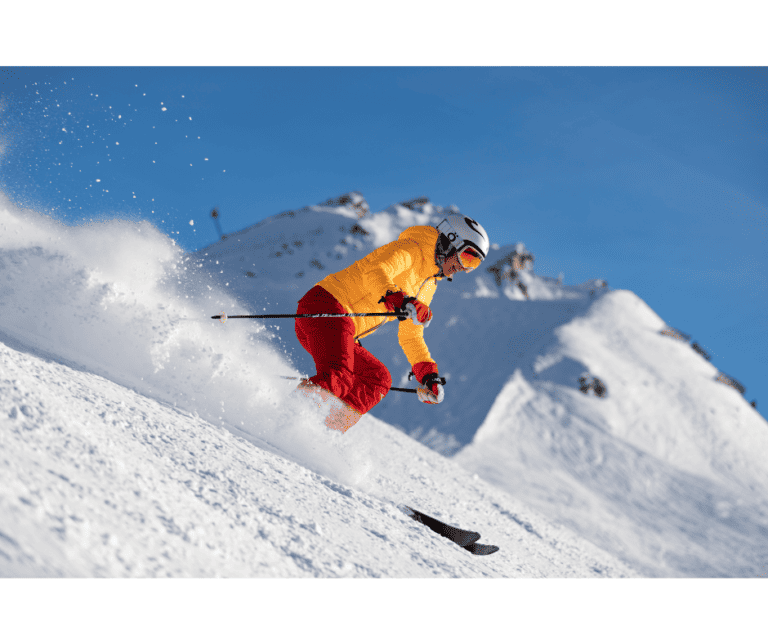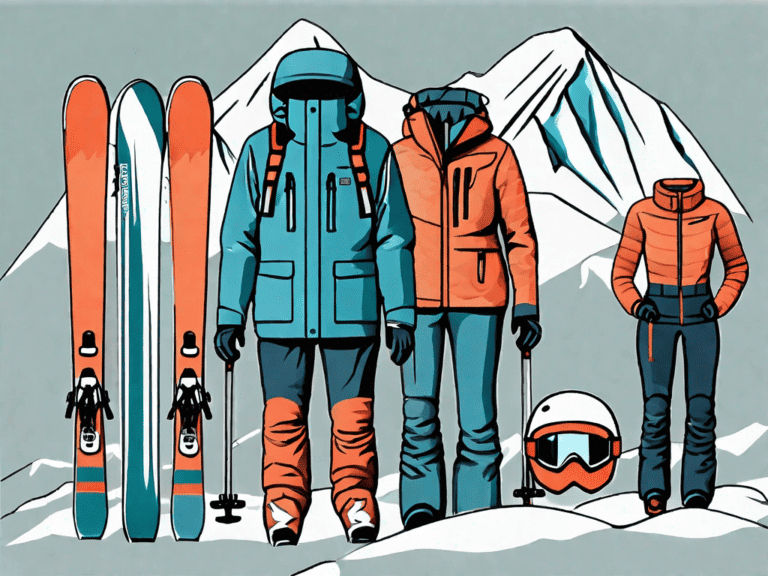How to Ski: A Beginner Skier’s Guide

Skiing offers a unique blend of excitement, physical challenge, and the serene beauty of snowy landscapes. The journey from a beginner skier to a proficient one is filled with milestones and memories. Imagine the thrill of your first successful descent, the satisfaction of mastering a new turn, and the joy of exploring picturesque trails.
Skiing is not just about speed and slopes; it’s about personal growth, overcoming fears, and the camaraderie found in the ski community.
Key Takeaways
How to Prepare For Ski Day
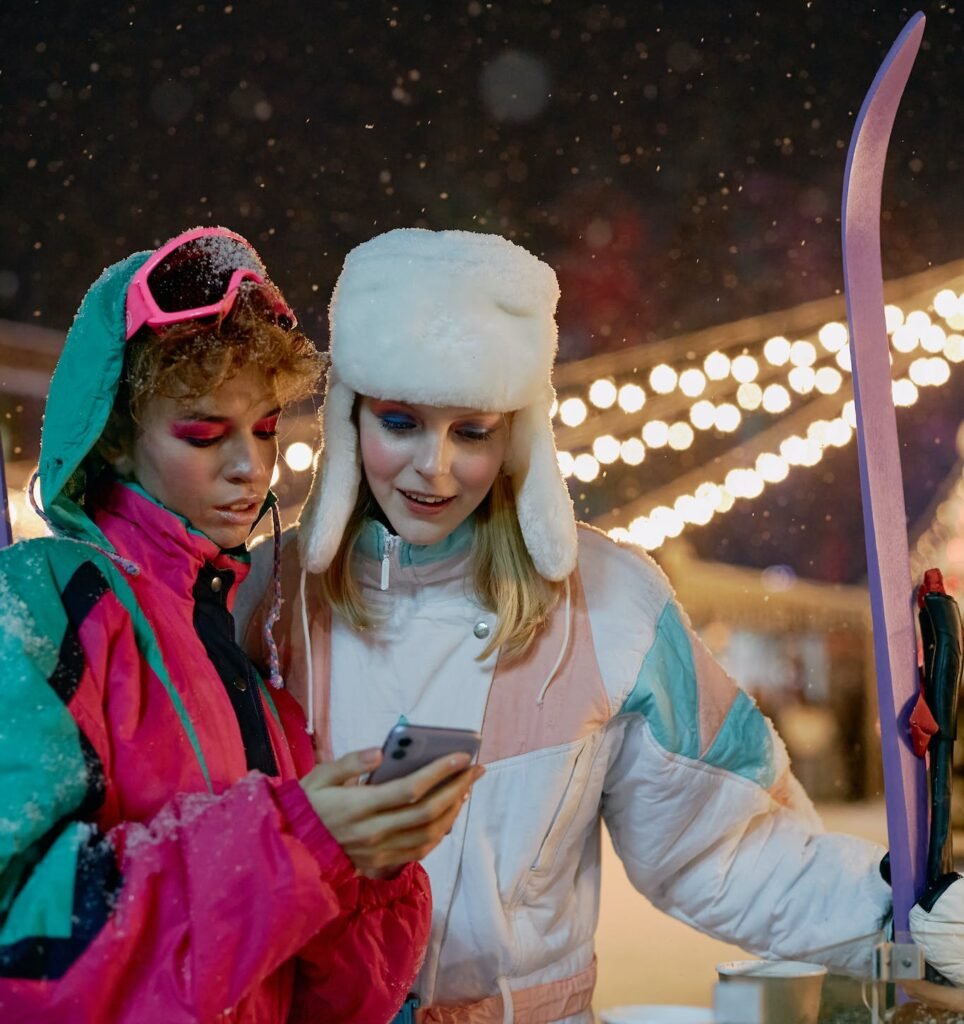
Planning Your Ski Day
Check Weather and Slope Conditions: Before anything else, check the local weather forecast and the conditions of the ski resort. Look for information on snowfall, temperature, and visibility. Many ski resorts provide real-time updates on their websites or social media channels regarding weather conditions and slope status. This information is crucial in helping you plan your attire, the type of gear you might need, and the slopes you plan to tackle.
Select the Right Slopes: As a beginner skier, choosing the appropriate slopes is key. Research the ski resort’s trail map beforehand. Familiarize yourself with the color-coded system that marks the difficulty level of each slope: green for easy, blue for intermediate, and black for advanced. Aim for green runs initially and progress to more challenging slopes as your confidence and skills grow.
Plan Your Arrival: Aim to arrive early, especially if you need to rent equipment or purchase lift tickets. Early arrival gives you the advantage of beating the crowds and enjoying fresher snow conditions.
Physical Warm-Ups and Exercises
General Warm-Up: Begin with a general warm-up to increase your heart rate and circulation. This could include light jogging, jumping jacks, or brisk walking. A proper warm-up readies your muscles and joints for the upcoming physical exertion and plays a key role in minimizing the risk of injury.
Ski-Specific Exercises: Focus on exercises that mimic skiing movements. Squats, lunges, and lateral side steps are great for activating the leg muscles. Include some core exercises, like planks or abdominal twists, to improve your balance and stability.
Flexibility Work: Flexibility is essential in skiing to maintain good form and reduce muscle stiffness. Incorporate stretches for your hamstrings, quadriceps, calves, back, and shoulders. Hold each stretch for about 30 seconds to ensure maximum benefit.
Balance Exercises: Since balance is a key component of skiing, practice balance exercises. Standing on one leg or using a balance board can be effective. These exercises enhance your proprioception, which is your body’s ability to sense movement, action, and location.
Final Preparations
Hydration and Nutrition: Stay well-hydrated and have a nutritious meal before you start. Skiing is energy-intensive, and proper hydration and fuel are crucial.
Mental Preparation: Finally, approach your ski day with a positive and relaxed mindset. Skiing is as much a mental game as it is a physical one. Being mentally prepared helps in overcoming challenges and enjoying the learning process.
What to Bring for a Day of Skiing
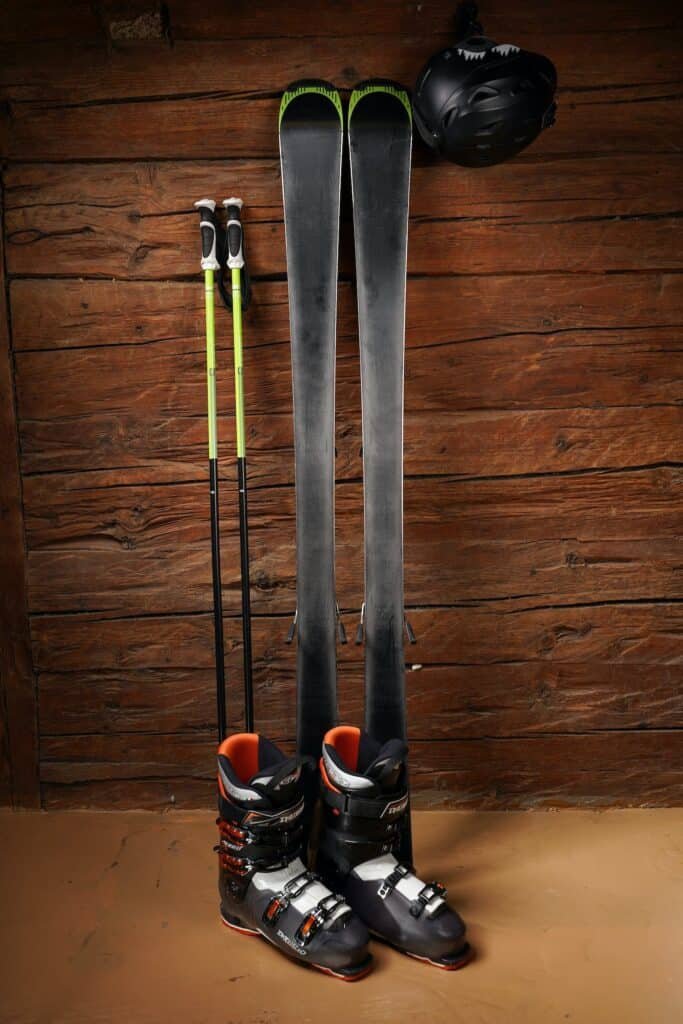
Essential Ski Gears
Skis: Choose skis that are appropriate for your skill level. Beginner skis are normally shorter and more flexible, which are easier to turn and manage.
Ski Boots: Comfortable, well-fitted ski boots are crucial. They should be snug but not painfully tight, providing adequate support for your ankles and feet.
Poles: Ski poles help with balance and timing. For beginners, poles should reach up to your armpits when standing on flat ground.
Safety Equipment
Helmet: A properly fitting ski helmet is non-negotiable for protecting your head from injuries. Make sure it’s comfortable and compatible with your goggles.
Goggles: Ski goggles are essential for protecting your eyes from glare, wind, and snow. They should fit snugly with your helmet without leaving any gaps.
Protective Padding: Consider wearing additional protective gear like wrist guards, knee pads, and padded shorts, especially if you are new to skiing and prone to falls.
Clothing
Base Layer: Start with a moisture-wicking base layer to keep you dry. Materials like merino wool or synthetic fibers work best.
Insulation Layer: Add an insulation layer for warmth. Fleece or a lightweight down jacket can provide the necessary warmth without being bulky.
Waterproof Outerwear: Your outer layer should be waterproof and windproof to protect against the elements. Look for a ski jacket and pants with these features.
Gloves or Mittens: Waterproof and insulated gloves or mittens are important to keep your hands warm and dry.
Hat or Beanie: If your helmet doesn’t cover your entire head, wear a thin beanie underneath it for extra warmth.
Socks: Wear a pair of ski-specific socks that are warm and thin. Avoid overly thick socks, as they can restrict blood flow and make your feet cold.
Additional Items
Sunscreen and Lip Balm: The sun can be strong on the slopes, so sunscreen and lip balm with SPF are important.
Snacks and Hydration: Pack light snacks and a water bottle to stay energized and hydrated throughout the day.
Backpack or Ski Bag: A small backpack or ski bag can be useful for carrying your essentials.
Choose the Right Gear
How to Select Ski Boots
Fit is Paramount: How ski boots fit? Ski boots should be snug but not painful. Your toes should lightly touch the ski boots’ front when standing, but pull back when you bend your knees into a skiing position.
Flex Rating: Look for ski boots with a softer flex if you’re a beginner. Softer boots are more forgiving and comfortable, making them ideal for learning.
Consider Professional Fitting: It’s highly recommended to get your ski boots professionally fitted at a ski shop. Custom-fitted boots can significantly improve your control and comfort.
Compatibility with Skis: Ensure that your ski boots are compatible with your bindings. This is usually not an issue with rental gear, but it’s crucial if you’re purchasing.
Picking Beginner-Friendly Skis
Length: Shorter skis are easier for beginners to handle. A general rule is to choose skis that reach somewhere between your chin and the top of your head.
Width and Shape: Look for skis that are wider and have a softer flex. These are more stable and easier to turn, making them suitable for beginners.
All-Mountain Skis: As a beginner, all-mountain skis are a good choice. They are designed to perform well in a variety of conditions and terrains.
Rent Before You Buy: Consider renting skis initially. This allows you to try out different types before making a purchase.
Importance of Ski Poles and Selection Tips
Balance and Rhythm: Ski poles help in maintaining balance and rhythm. They are essential for timing your turns and can aid in propulsion on flat terrain.
Choosing the Right Length: To test the length, turn the pole upside down and hold it under the basket (the circular part near the bottom). The right size will have your elbow at a 90-degree angle.
Grip and Straps: Ensure that the poles have a comfortable grip and adjustable straps. Padded or ergonomic grips can reduce fatigue in your hands.
Material and Weight: Most poles are made from aluminum or composite materials. Beginners may prefer lighter poles for easier handling.
Get to Know Your Skiing Environment
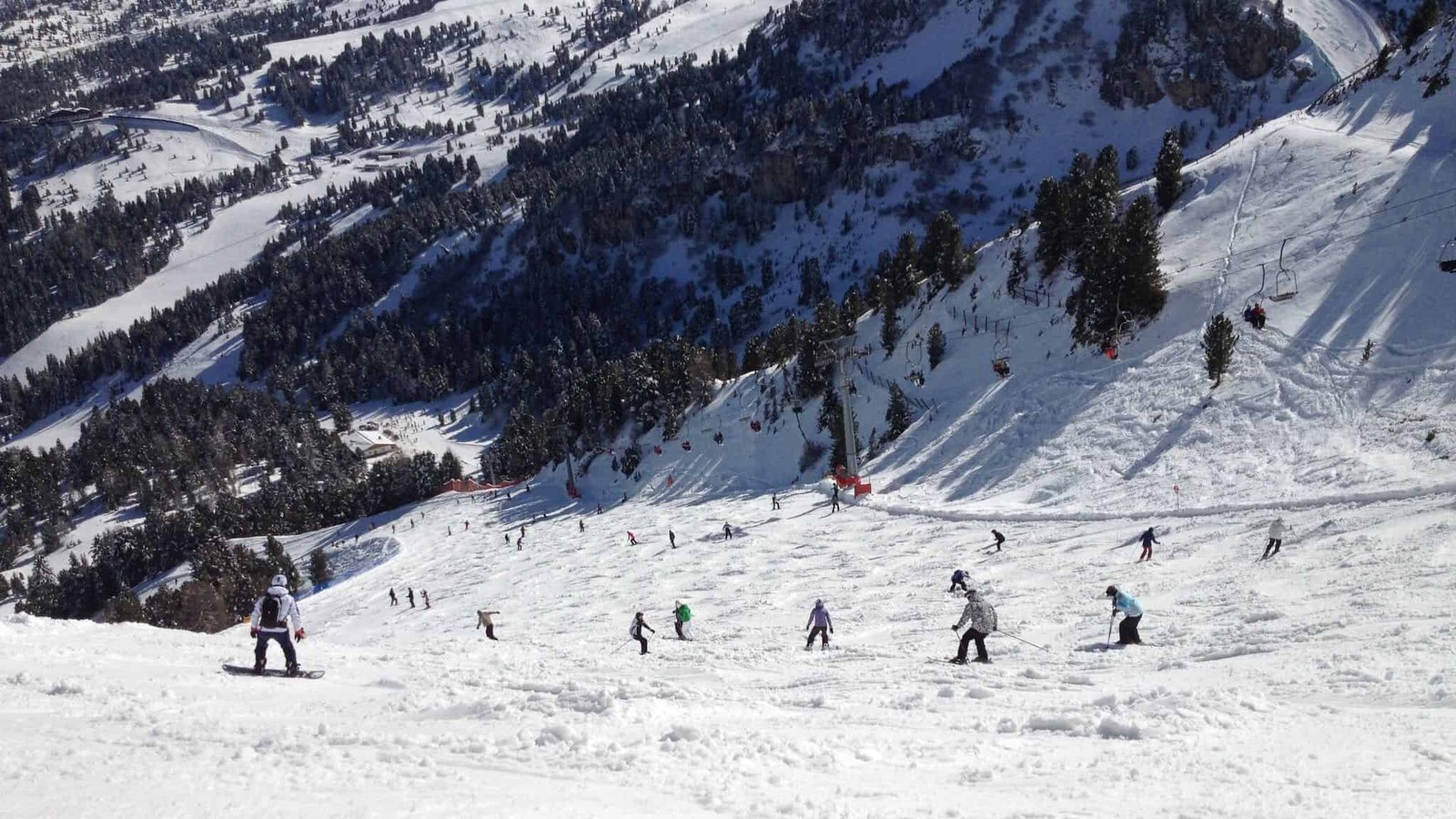
How to Read The Ski Resort Map
Layout of the Resort: Ski resort maps provide an aerial view of the entire resort, including the location of all the ski lift, slopes, lodges, and other facilities. Familiarize yourself with the layout to plan your day efficiently.
Identifying Lifts and Trails: The map will show all the ski lifts, including gondolas, chairlifts, and surface lifts, along with their names or numbers. Trails are marked with lines showing their path from the top to the bottom.
Symbols and Signs: Pay attention to the symbols and signs on the map. These may indicate the location of essential services like first aid, restaurants, restrooms, and ski schools.
Map Legends: Use the map legend to understand the symbols used. Legends typically include information on the direction of North, the scale of the map, and color coding for different types of facilities.
Learning About Different Slope Ratings
Color-Coded System: Slopes are typically rated using a color-coded system to indicate their difficulty level. This system helps skiers choose trails suitable for their skill level.
Green Circles: These are designated for easy slopes, ideal for beginners. Green runs are wide, have gentle gradients, and are perfect for practicing basic skiing skills.
Blue Squares: Intermediate slopes that are slightly steeper and may have more varied terrain. They are suitable for skiers who are comfortable with basic turns and speed control.
Black Diamonds: Advanced slopes with steep gradients and potentially challenging terrain features like moguls or narrow passages. These are for experienced skiers.
Resort-Specific Ratings: Keep in mind that slope ratings are resort-specific. A green slope at one resort may be more or less challenging than a green slope at another. Always start with the easiest slopes to gauge the difficulty level at a new resort.
Other Symbols: Apart from the basic ratings, some maps may have additional symbols for terrain parks, off-piste areas, and extreme terrain (like double black diamonds). As a beginner, you should steer clear of these until you gain more experience.
Basic Techniques of Skiing For Beginner Skiers

Fundamental Skiing Stance and Balance
Athletic Stance: Adopt an athletic stance with your feet shoulder-width apart. This stance provides stability and flexibility. Keep your knees slightly bent and your weight centered over your boots.
Weight Distribution: Balance your weight evenly across both skis. As you progress, you’ll learn to shift your weight from one ski to the other, which is key for turning and maneuvering.
Upper Body Position: Keep your upper body upright and your hands forward. Your arms should be slightly bent with your hands over the ski tips. This position helps with balance and direction.
Head and Eye Position: Look in the direction you want to go. Keeping your head up and eyes forward helps with balance and awareness of your surroundings.
Simple Movements: Gliding, Stopping, and Turning
Gliding: Start on a gentle slope. Push off gently using your ski poles and allow your skis to glide straight down the slope. Keep your skis parallel and practice keeping your balance as you glide.
Stopping (Snowplow or Wedge Stop): To stop, use the snowplow technique. Begin in a gliding position, then slowly push the tails of your skis apart while keeping the tips together. The wider you push your ski tails, the more resistance you create, and the quicker you will stop.
Basic Turning: Turning is a crucial part in downhill skiing. Turning initially involves the snowplow technique. Start with the snowplow position, then gently shift your weight onto the ski opposite the direction you want to turn. For example, to turn right, put more weight on your left ski. This shift in weight will naturally cause your skis to turn.
Practice on Gentle Slopes: Begin practicing these techniques on gentle slopes. As you become more comfortable with controlling your downhill ski, the ski that is lower on the slope during a turn, gradually moves to steeper terrain. Mastering the use of your downhill ski is crucial as you progress, as it helps in effectively managing turns and maintaining balance on more challenging slopes.
Progressing to Parallel Turns: Once you are comfortable with snowplow turns, you can start practicing parallel turns. This involves keeping your skis parallel throughout the turn, which requires more balance and control.
How to Use Ski Lifts Safely
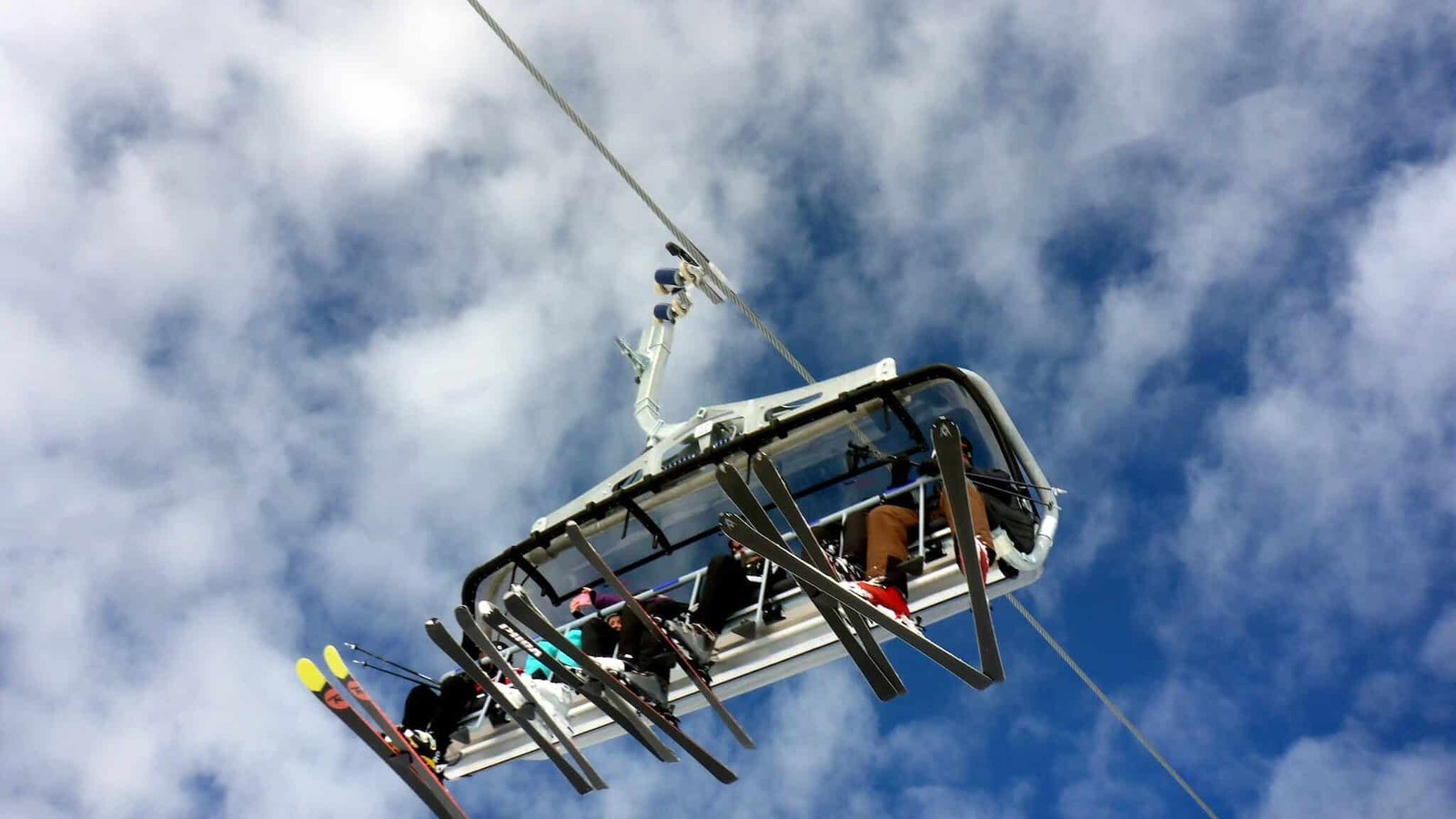
Types of Ski Lifts and How to Use Them
Chairlifts: The most common type of lift, chairlifts carry skiers up the mountain while they sit. To board a chairlift, approach the line and wait for your turn. As the chair comes around, move forward to the designated mark, look over your shoulder to see the chair, grab the outer rail, and sit down as it reaches you. Keep your ski tips up as you move away from the station.
T-Bar and Button Lifts: These are surface lifts where you remain standing on your skis. The T-bar is placed behind your thighs, and you lean back slightly against it. Button lifts have a disc on a long pole that you place between your legs to pull you up the slope. Keep your skis parallel and look forward, not at your feet.
Gondolas and Cable Cars: These enclosed lifts are great for longer and higher ascents. Enter the gondola when instructed, and take a seat or stand if there are no seats. Remove your skis and carry them inside with you.
Tips for Getting On and Off Lifts Without Hassle
Prepare in Advance: As you approach the lift, make sure your ski poles are in one hand. If it’s a chairlift or gondola, ensure your lift ticket is visible for scanning.
Timing Your Entry: Pay attention to the lift attendant’s instructions and the movements of other skiers. Move forward promptly when it’s your turn.
Sitting on Chairlifts: For chairlifts, sit back firmly in the chair and pull down the safety bar if there is one. Keep your ski tips up and avoid swinging your legs.
Exiting the Lift: Prepare to exit by lifting the safety bar (for chairlifts) as you approach the offloading area. Keep your skis parallel to the ground, stand up smoothly as the lift slows down, and ski gently away from the offloading area.
Falling Off a Lift: If you fall while getting on or off the lift, stay calm. The lift operators are trained to stop the lift and will assist you.
Practice Makes Perfect: Don’t be discouraged if you don’t get it right the first time. Ski lift can take a little practice, and it’s perfectly normal for beginners to need a few tries to get comfortable.
How To Navigate The Slopes
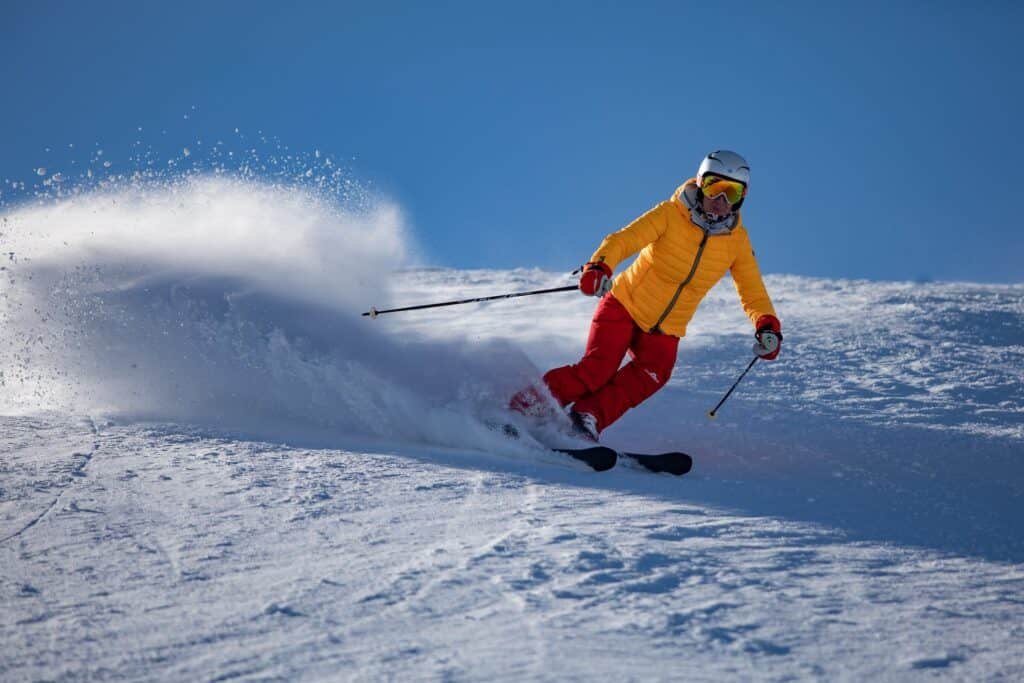
Starting on Beginner Slopes
Choose the Right Slopes: Begin with green runs, which are designated for beginners. These slopes have gentle gradients and are wide, providing a comfortable environment for learning basic skiing techniques.
Familiarize with the Slope: Before starting, take a moment to look at the slope. Note its width, steepness, and any variations in terrain. Identify a comfortable path you plan to take down the slope.
Control Your Speed: Start with a slow, controlled speed. Use the snowplow technique to regulate your speed as you become more comfortable with gliding and turning.
Practice Basic Turns: Practice making gentle turns using the snowplow method. Start with wide, sweeping turns, and gradually make them tighter as you gain confidence.
Rest When Needed: If you feel tired, stop at a safe spot on the side of the trail. Remember, skiing uses muscles you may not be used to exercising with, so taking breaks is important.
Advancing to More Challenging Trails
Progress Gradually: Once you’re comfortable on green runs, consider trying a blue run. Blue runs are intermediate trails that offer a bit more challenge with steeper gradients and varied terrain.
Ski with a Buddy: When trying a new trail, it’s a good idea to ski with someone who knows the trail or with a more experienced skier. They can provide guidance and support.
Prepare Mentally and Physically: Before tackling more difficult slopes, ensure you are mentally and physically prepared. You should feel confident in your basic skiing skills and have the physical stamina to handle longer and steeper runs.
Learn to Read the Terrain: As you progress, start learning to read the terrain. Pay attention to changes in slope steepness, snow conditions, and any obstacles like bumps or icy patches.
Take Ski Lessons: Consider taking a lesson if you’re moving up to more challenging slopes. Instructors can provide valuable tips and techniques specific to handling steeper and more complex terrains.
Respect Your Limits: Always ski within your ability level. If a trail feels too challenging, it’s okay to turn back. Safety should always be your top priority.
Ski Safety and Etiquette
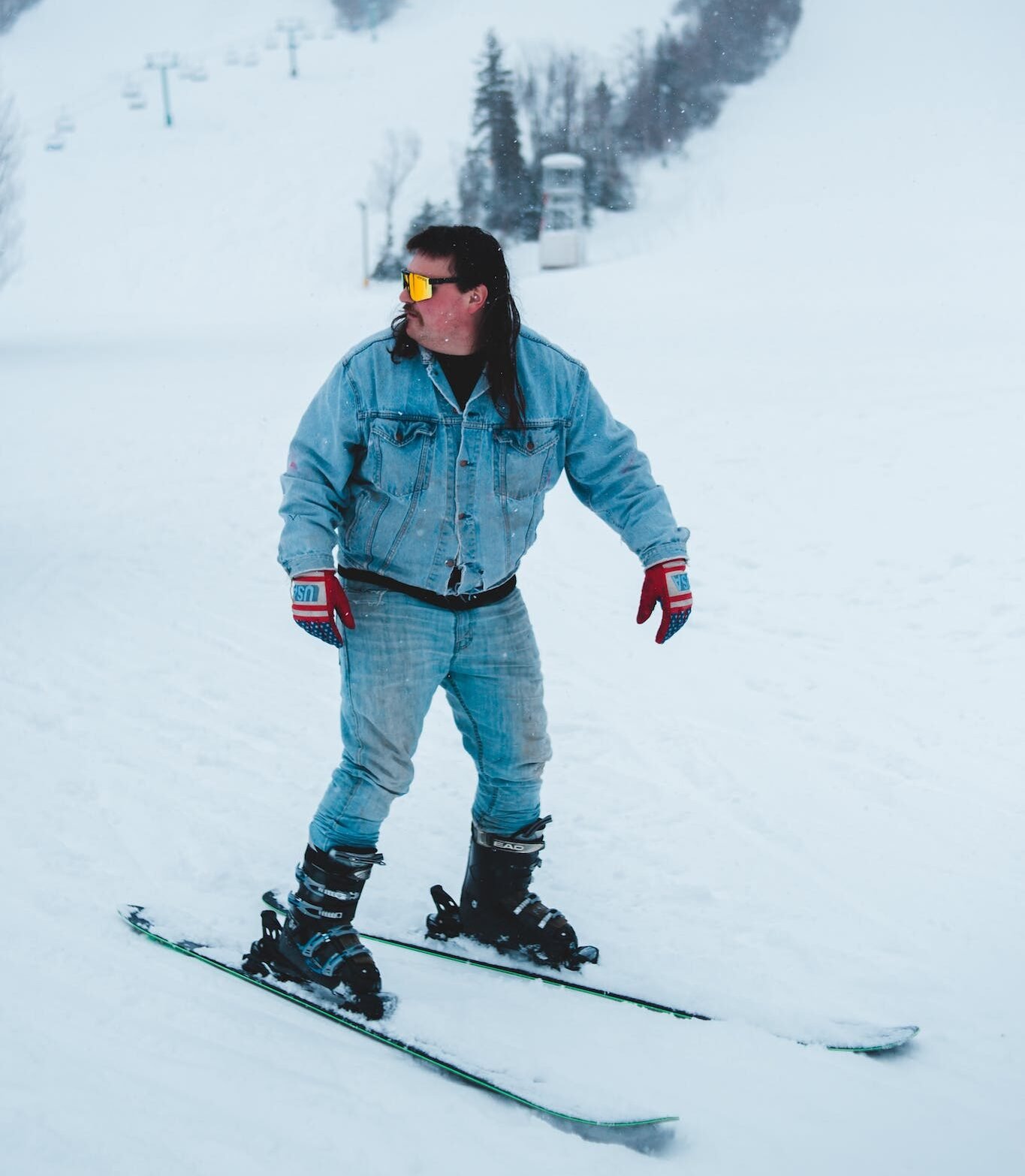
Key Safety Tips While Skiing
Stay in Control: Always ski within your ability level. Be able to stop or avoid other people or objects. Losing control is the main cause of accidents on the slopes.
Look Ahead: Be aware of your surroundings, including other skiers and obstacles. Look ahead and be prepared to adjust your path or speed to avoid hazards.
Yield to Skiers Ahead: The skier in front of you has the right of way. It’s your responsibility to avoid them, as they may not be aware of you.
Use Proper Ski Gear: Always wear a helmet and ensure that all your equipment is in good working condition. Proper gear can prevent or reduce the severity of injuries.
Respect Signs and Warnings: Obey all signs and warnings. They are there for your safety. This includes staying out of closed areas.
Know Your Limits: Fatigue can lead to accidents. Take breaks, and don’t push yourself too hard, especially towards the end of the day.
Practice Slope Etiquette
Respect Others: Skiing is a shared experience. Be courteous and respectful to other skiers and snowboarders, regardless of their skill level.
Stopping Safely: If you need to stop, do so at the side of the slope in a visible area. Avoid stopping in narrow places or where you are not visible from above.
Helping in Accidents: If you are involved in or witness an accident, help the person and inform ski patrol immediately. Don’t leave the scene unless necessary.
Overtaking Carefully: When overtaking another skier, leave enough space to allow for voluntary or involuntary movements. It’s better to err on the side of caution.
Maintain a Safe Distance: Keep a safe distance from other skiers to avoid collisions, especially in crowded areas or lift lines.
Keep Off the Uphill Track: Avoid skiing or walking in the uphill track of surface lifts like T-bars or rope tows.
How To Improve Your Skill
Take Lessons: Professional instruction is one of the most effective ways to improve your skiing skills. Instructors can provide personalized feedback, introduce new techniques, and help correct any bad habits.
Practice Regularly: Like any sport, skiing requires regular practice. The more time you spend on the slopes, the more comfortable and skilled you become. Try to ski regularly, and focus on practicing specific skills each time.
Set Achievable Goals: Set small, achievable goals for each ski day or season. This could be mastering a particular type of turn, feeling confident on blue runs, or improving your speed control.
Video Analysis: Recording your skiing can be incredibly helpful. Watching yourself ski can reveal areas for improvement that you may not be aware of while skiing.
Focus on Technique Over Speed: While it’s tempting to equate speed with skill, focusing on technique is more beneficial. Good technique naturally leads to better control and, eventually, increased speed.
Condition Your Body: Off-slope physical conditioning can significantly impact your skiing performance. Engage in exercises that build leg strength, flexibility, and core stability.
The Value of Skiing with More Experienced Skiers
Learning by Observation: Skiing with those who are more skilled provides an opportunity to observe and learn. Watch how they handle different terrains and conditions, and try to emulate their techniques.
Receiving Tips and Feedback: Experienced skiers can offer valuable tips and instant feedback on your skiing style. They can point out things you may not realize you’re doing.
Building Confidence: Skiing with better skiers often pushes you slightly out of your comfort zone, which can accelerate your improvement. However, it’s important they understand your limits to avoid pushing you into unsafe situations.
Exploring New Terrain: More experienced skiers can introduce you to new parts of the mountain that you might not have ventured to on your own. Skiing different terrains is a great way to improve.
Enjoyment and Motivation: Skiing with others who share your passion can be more enjoyable and motivating. It can turn a solitary sport into a social and fun activity, increasing your desire to improve.
How To Clean Your Ski Gear

Skis and Poles: Wipe down your skis and poles with a dry cloth to remove any moisture and prevent rust. Pay special attention to the metal edges and bindings. If the skis are particularly dirty, use a mild soap and water solution, but avoid soaking the bindings.
Boots: Remove the liners from your ski boots and let them air out. Wipe the shells with a damp cloth to clean off any snow and dirt. Ensure the boots are completely dry before storing them.
Clothing: Follow the washing instructions on your ski clothing. Most ski wear should be washed in cold water and air-dried. Avoid using fabric softeners as they can degrade the waterproofing properties of the fabric.
How To Store Your Ski Gears
Skis: Store skis in a cool, dry place. Avoid leaving them in direct sunlight or in a damp area like a basement. You can hang them or store them flat, but avoid resting them on their tails or tips for extended periods.
Boots: Once dry, reinsert the liners into your boots. Buckle the boots loosely to maintain their shape and store them in a dry place. Avoid storing boots in direct heat or sunlight.
Poles: Store poles in a dry area. If they are adjustable, release the tension to prolong their life.
Maintenance Tips
Regular Waxing: Regularly waxing your skis will keep them gliding smoothly and protect the base from damage. The frequency depends on how often you ski, but a good rule of thumb is to wax them every few ski days.
Edge Sharpening: Sharp edges are crucial for good control, especially on icy slopes. Have your ski edges professionally sharpened regularly or learn to do it yourself.
Yearly Checks: At the end of the season, or at least once a year, have your skis and bindings checked and adjusted by a professional. This ensures they are in good working order and safe to use.
Protective Storage: Consider using ski bags for storing and transporting your skis and poles. This protects them from scratches and other damage.
Avoiding Rust: To prevent rust, make sure your skis and bindings are completely dry before storing them. If you notice any rust on the edges, remove it with a gummy stone.
Video Tutorial
You should watch this video by Stomp It Tutorials for additional tips and information as a beginner skier. They have lots of videos about skiing if you want to learn more.
Conclusion
Skiing is not just about mastering the physical act of gliding down snowy slopes; it’s about embracing a lifestyle that celebrates the outdoors, challenges personal boundaries, and fosters a sense of community among fellow enthusiasts. As a beginner, the learning curve might seem steep at times, but with patience, practice, and a willingness to learn, you will find that skiing opens up a world of adventure and fun.
Remember the importance of starting with the right gear that suits your level and ensures your safety. Familiarize yourself with the skiing environment and take the time to learn and practice basic skiing techniques. Respect the mountain and your fellow skiers by following safety guidelines and slope etiquette. As you gain confidence, challenge yourself with new slopes and techniques, and consider skiing with more experienced skiers to enhance your skills.
Moreover, the care and maintenance of your gear are as much a part of the sport as skiing itself. Proper upkeep not only ensures the longevity of your equipment but also your safety and performance on the slopes.
Above all, skiing is about enjoying the journey. Each run, each fall, and each triumph is a part of the incredible experience of being a skier. So, embrace each moment, enjoy the beauty of the mountains, and cherish the joy that skiing brings. Welcome to the wonderful world of skiing – may your trails be smooth, your skies clear, and your adventures plentiful!

